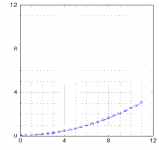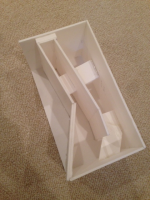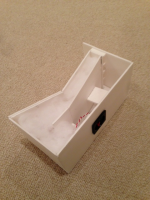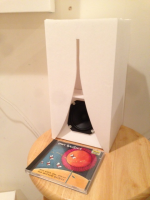Djn,
The K-slot curve is actually not as critical as how wide the gap is at the narrow end and how long it is. I actually hand-drew the arc portion and made the skinny part about 3/8 in wide and truncated it about 3 in from the top. For your single driver version, maybe 1/4 in in wide slot that stops 1.5 in from the top is good. You are an artist so I know you can hand draw a smooth arc from the 1/4 in wide slot to the bottom corner. If you want to be perfect, I have converted the published K-slot (from K15) into a mathematical function which can be scaled. I can generate a curve for you if you want - give me a couple hours. How is the build going?
X
Edit: Here is the curve coordinates (note that x is the along the height of the speaker and x=0 is at 1 in from the top, thus at 11 in the bottom of the speaker y coordinate should equal half the width of the front baffle.
If you are interested, the function in non-dimensional units (0 to 1) is given by: y(x)=0.974 * X^2 + 0.00874 * X + 0.0207
Enter values of x from 0 to 1 and scale that by your height. The resulting answer for y varies from 0 to 1 and scale that by half the baffle width.
The K-slot curve is actually not as critical as how wide the gap is at the narrow end and how long it is. I actually hand-drew the arc portion and made the skinny part about 3/8 in wide and truncated it about 3 in from the top. For your single driver version, maybe 1/4 in in wide slot that stops 1.5 in from the top is good. You are an artist so I know you can hand draw a smooth arc from the 1/4 in wide slot to the bottom corner. If you want to be perfect, I have converted the published K-slot (from K15) into a mathematical function which can be scaled. I can generate a curve for you if you want - give me a couple hours. How is the build going?
X
Edit: Here is the curve coordinates (note that x is the along the height of the speaker and x=0 is at 1 in from the top, thus at 11 in the bottom of the speaker y coordinate should equal half the width of the front baffle.
Code:
xdim (in) ydim (in)
0.00 0.063
0.50 0.070
1.00 0.090
1.50 0.122
2.00 0.166
2.50 0.223
3.00 0.291
3.50 0.372
4.00 0.466
4.50 0.571
5.00 0.689
5.50 0.819
6.00 0.962
6.50 1.116
7.00 1.283
7.50 1.462
8.00 1.654
8.50 1.858
9.00 2.074
9.50 2.302
10.00 2.542
10.50 2.795
11.00 3.060If you are interested, the function in non-dimensional units (0 to 1) is given by: y(x)=0.974 * X^2 + 0.00874 * X + 0.0207
Enter values of x from 0 to 1 and scale that by your height. The resulting answer for y varies from 0 to 1 and scale that by half the baffle width.
Attachments
Last edited:
So X, is the padding in the inside of the wings and maybe on the walls something you've had time to evaluate further, and is it something that you will recommend that others do?
For it to work most effectively I'd think it should have even thickness right to the edge of the curve on the wing, but not thicker than the longest wavelength that you want to diffract with the slotlens or that will "fit" in the slot.
For it to work most effectively I'd think it should have even thickness right to the edge of the curve on the wing, but not thicker than the longest wavelength that you want to diffract with the slotlens or that will "fit" in the slot.
Last edited:
Squeak,
I like the way my Karlsonator sounds with the poly fill stuffing placed behind the wings right up to the curve. I have it on the lower half of the front baffle. The best thing is to adjust it to taste. Too much and you lose high freq detail. When it is just right there is an improvement in stereo imaging and the sound stage opens up. I recommend this for others to try. It is easy to do, is reversible, and doesn't cost anything.
Good idea.
Thanks?
X
I like the way my Karlsonator sounds with the poly fill stuffing placed behind the wings right up to the curve. I have it on the lower half of the front baffle. The best thing is to adjust it to taste. Too much and you lose high freq detail. When it is just right there is an improvement in stereo imaging and the sound stage opens up. I recommend this for others to try. It is easy to do, is reversible, and doesn't cost anything.
Good idea.
Thanks?
X
You're quite welcome. ;-)
As with anything in audio it's not a new idea though. Foam and fibre lenses has been used on arrays and tweeters for years. It steals some efficiency at the top (which FR units has loads of) with less beaming as the result.
Also, foam has been used by Geddes in his horns/waveguides to take out the "honk".
This could do both things for the Karlson slot, with the cavity resonance at the front being the only real serious drawback of the design.
Strange that he didn't think of it himself BTW.
Gotta get a pair of these build soon, to walk the walk.
As with anything in audio it's not a new idea though. Foam and fibre lenses has been used on arrays and tweeters for years. It steals some efficiency at the top (which FR units has loads of) with less beaming as the result.
Also, foam has been used by Geddes in his horns/waveguides to take out the "honk".
This could do both things for the Karlson slot, with the cavity resonance at the front being the only real serious drawback of the design.
Strange that he didn't think of it himself BTW.
Gotta get a pair of these build soon, to walk the walk.
Last edited:
Hmm... A block of reticulated foam that goes on the front K slot might be worth trying.
Yes, Squeak, you really should build a set. Use the Faital 4FE22 in a single driver with a 0.4x scale. It is small and easy to make and I think you can then experience the Karlson aperture for yourself. Or try the dual Vifa in 0.53x scale. I really like how these sound.
Yes, Squeak, you really should build a set. Use the Faital 4FE22 in a single driver with a 0.4x scale. It is small and easy to make and I think you can then experience the Karlson aperture for yourself. Or try the dual Vifa in 0.53x scale. I really like how these sound.
My mistake, I meant 4FE32 - the 4 ohm Neodymium magnet full range.
FaitalPRO 4FE32 4" Neodymium Professional Woofer 4 Ohm | 294-1120
The ferrite magnet version of the same driver will also work too - costs a bit less.
FaitalPRO 4FE35 4" Professional Woofer 4 Ohm | 294-1123
FaitalPRO 4FE32 4" Neodymium Professional Woofer 4 Ohm | 294-1120
The ferrite magnet version of the same driver will also work too - costs a bit less.
FaitalPRO 4FE35 4" Professional Woofer 4 Ohm | 294-1123
I just noticed a new full range driver from the pro audio lineup. It has a 91 dB efficiency and goes up to 18kHz, and can handle 100 watts continuous power.
Galaxy Audio S5N-8 5" Neodymium Full Range Driver 8 Ohm | 290-020
This might be interesting in a 0.5x scale Karlsonator. Nice Qts of 0.49 - a good range for many alignments - a bit pricey though at $49 ea. Anyone have experience with these?
Galaxy Audio S5N-8 5" Neodymium Full Range Driver 8 Ohm | 290-020
This might be interesting in a 0.5x scale Karlsonator. Nice Qts of 0.49 - a good range for many alignments - a bit pricey though at $49 ea. Anyone have experience with these?
I remember that note on the plans for the original Karlson - basically the inside of the wings and front baffle should be as smooth as possible. This is opposite to what what I perceive as smoother highs and better imaging with some fluffy damping right beneath the lower portion of the wings.
You should try it Freddi and tell me if it works. I think in a K15, the high frequencies that I am talking about are not as pronounced because the wings are huge and dealing with the bass and mid bass. The highs typically come from the coax compression driver or a separate K tube tweeter.
You should try it Freddi and tell me if it works. I think in a K15, the high frequencies that I am talking about are not as pronounced because the wings are huge and dealing with the bass and mid bass. The highs typically come from the coax compression driver or a separate K tube tweeter.
My mistake, I meant 4FE32 - the 4 ohm Neodymium magnet full range.
FaitalPRO 4FE32 4" Neodymium Professional Woofer 4 Ohm | 294-1120
The ferrite magnet version of the same driver will also work too - costs a bit less.
FaitalPRO 4FE35 4" Professional Woofer 4 Ohm | 294-1123
T/S parameters seem to differ in the 3" and 4" Faital driver lines, between models of different nominal impedance and magnet material. The 4ohm Neo 4FE32 seems the best suited with the lowest Qt of 0.5.
IG
I remember that note on the plans for the original Karlson - basically the inside of the wings and front baffle should be as smooth as possible. This is opposite to what what I perceive as smoother highs and better imaging with some fluffy damping right beneath the lower portion of the wings.
Strangely enough, we've been arguing about this issue for years. There was no shortage of discussion on this matter on the Gregg Baker's old Karlson forum.
Yes, in the plans and notes it was typically recommended that the inside chamber be shellacked to maximize the high frequencies. I think this has a lot to do with the typical drivers people used back in the day, which could easily end up with a pretty serious BBC dip- perhaps more like a BBC canyon.
However, in the actual patent description, Karlson discusses adjusting the tone (or something like that) by varying texture of the interior surface. I'd have to go back and read it, but IIRC he mentions felt or something.
In my relatively limited experience, I'd say a hard shellacked surface does muck up imaging a bit, as well as adding a sort of reverberant quality to the sound that may or may not be desired. The sound gets sort of confused, for lack of a better description. Shellacking the inner surface does (not surprisingly) reduce the HF losses from bandpass effects.
In the larger K15 it doesn't seem to matter as much, as in the smaller K12. If I were to build a new small Karlson type for myself, I would try lining the inside of the chamber with thin cork, and possibly glue some felt right behind the wings in front of the driver. This will probably eat up some HF, and make a rising response horn type specs driver a prerequisite.
Years ago, Ron C shared some interesting data on the reflectivity of surfaces. It was surprising how much difference there was between a rough sanded plywood and a varnished/shellacked surface.
Also the angle at which the HF reflects off the surface plays a large role too, just as with light.
Read this thread for some pretty good explanations and advice on using selectively absorbant foam lenses: Speaker Directivity - The Gear Page
Read this thread for some pretty good explanations and advice on using selectively absorbant foam lenses: Speaker Directivity - The Gear Page
Last edited:
THanks X, I did up an excel spreadsheet for scaling, but then realized the picture you posted, I can just print to scale until it is right. With the kids in town for Thanksgiving, and the addition to the shop half done, the build will have to wait a week or two.
I just started on the single driver 0.4x scale Karlsonator this morning. It is a cute little speaker at 12 in tall 6 in wide x 6.5 in deep. Very easy to make out of foam core due to the small size of all the pieces.
0.4x Scale Karlsonator with single Vifa - Build 3 - Completed
The speaker is completed. Here is a photo of it with a CD case for size reference. It is very small and compact at 12 in tall x 6 in wide x 6.5 in deep. This size is perfect for a bookshelf or a desk.
How does it sound? In a word - amazing! It sounds very very good. The highs are clearer than the dual driver 0.54x scale version . I think it may be that the direct radiator cone area is better matched to the Karlson aperture size in this format - or the mid-bass is cleaner? The bass extension is quite nice - not as deep of course as the 0.54x version - but very satisfying. I played "Sermon on the Mount" by Dave Brubeck and his sons - there is a beautiful Cello and it comes through very natural and smooth. I played some Robert Cray and that sounded great. If you pair this with a sub crossed at 80 Hz and below it will really shine - but it sounds great as is. For a desktop computer speaker, it will easily beat a $100+ pair that is out there. The wide angle directivity is very nice and apparent when you step back and walk around the room - it sounds very uniform.
Anyhow, I don't have any reservations about recommending this build. You will not be disappointed. For the cost of a $10 Vifa, 1 sheet of foam core, some pillow stuffing, and a $0.85 terminal cup - this speaker is awesome!
I am very happy with it.
Cheers,
X
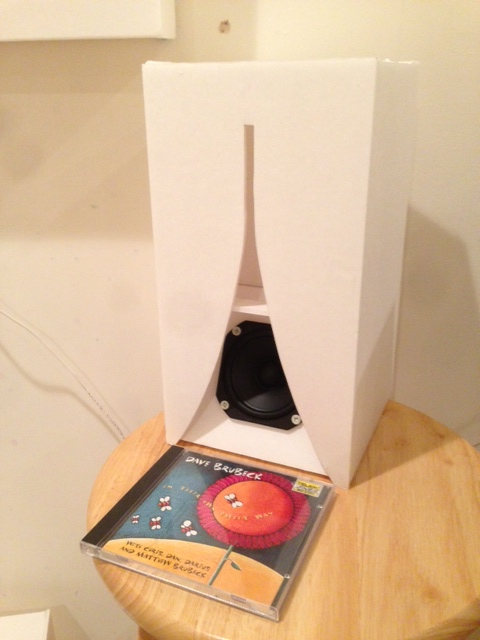
The speaker is completed. Here is a photo of it with a CD case for size reference. It is very small and compact at 12 in tall x 6 in wide x 6.5 in deep. This size is perfect for a bookshelf or a desk.
How does it sound? In a word - amazing! It sounds very very good. The highs are clearer than the dual driver 0.54x scale version . I think it may be that the direct radiator cone area is better matched to the Karlson aperture size in this format - or the mid-bass is cleaner? The bass extension is quite nice - not as deep of course as the 0.54x version - but very satisfying. I played "Sermon on the Mount" by Dave Brubeck and his sons - there is a beautiful Cello and it comes through very natural and smooth. I played some Robert Cray and that sounded great. If you pair this with a sub crossed at 80 Hz and below it will really shine - but it sounds great as is. For a desktop computer speaker, it will easily beat a $100+ pair that is out there. The wide angle directivity is very nice and apparent when you step back and walk around the room - it sounds very uniform.
Anyhow, I don't have any reservations about recommending this build. You will not be disappointed. For the cost of a $10 Vifa, 1 sheet of foam core, some pillow stuffing, and a $0.85 terminal cup - this speaker is awesome!
I am very happy with it.
Cheers,
X

Attachments
Last edited:
- Home
- Loudspeakers
- Full Range
- Mini Karlsonator (0.53X) with Dual TC9FDs
